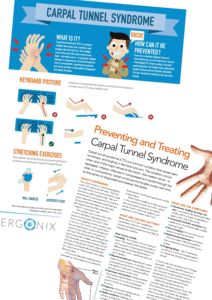 Carpal Tunnel Syndrome (CTS) is a common condition causing discomfort and pain in the hand, wrist, and forearm, which can make everyday tasks uncomfortable, painful and difficult. In workplaces and office environments where employees spend long hours at computers or performing repetitive tasks, CTS can quietly develop and worsen if left unaddressed. By understanding the risks, recognising symptoms early, and implementing supportive workplace practices, employers can play a vital role in reducing the impact of CTS and maintaining employee comfort, productivity, and wellbeing.
Carpal Tunnel Syndrome (CTS) is a common condition causing discomfort and pain in the hand, wrist, and forearm, which can make everyday tasks uncomfortable, painful and difficult. In workplaces and office environments where employees spend long hours at computers or performing repetitive tasks, CTS can quietly develop and worsen if left unaddressed. By understanding the risks, recognising symptoms early, and implementing supportive workplace practices, employers can play a vital role in reducing the impact of CTS and maintaining employee comfort, productivity, and wellbeing.
What is Carpal Tunnel Syndrome?
CTS occurs when the median nerve, which passes through a narrow tunnel in the wrist called the carpal tunnel, becomes compressed. This nerve controls sensation in the thumb, index, middle, and part of the ring finger, as well as some hand movements.
When the carpal tunnel narrows — due to swelling, irritation, or pressure — the nerve is squeezed, which can cause pain, tingling, numbness, weakness, and loss of sensation in the hand and fingers.
Risk Factors in the Office
CTS usually develops over time due to a combination of factors. While it can affect anyone, certain workplace and personal factors increase the likelihood:
- Repetitive hand and wrist movements, such as typing or mouse use for extended periods without breaks.
- Poor wrist position, particularly sustained bending or extreme flexion/extension of the wrist while working.
- Prolonged gripping, even lightly, as when holding a phone or book for long periods.
- Improper workstation setup, requiring awkward hand or arm positions to reach the keyboard or mouse.
- Use of vibrating equipment (less common in office settings, but possible with certain tools or machinery).
- Health conditions such as diabetes, rheumatoid arthritis, and thyroid disorders, which can increase susceptibility.
- Hormonal changes, particularly during pregnancy, which can cause fluid retention and swelling.
- Heredity, as some people naturally have a smaller carpal tunnel or anatomical variations.
Recognising the Symptoms
CTS symptoms often develop gradually and may come and go at first, making them easy to overlook. Early recognition and action can prevent progression. Watch for these signs:
- Numbness, tingling, or burning sensations in the thumb, index, middle, and ring fingers — often worse at night or after using your hands.
- Pain that can radiate from the wrist up the forearm toward the shoulder.
- Shock-like sensations in the fingers.
- Weakness or clumsiness when gripping, buttoning clothes, or holding objects — leading to dropping things.
- Symptoms that wake you during the night, especially if you sleep with wrists bent.
- Discomfort when holding objects (like a book or phone) for long periods.
What Employers Can Do
Supporting employees begins with creating a workplace that reduces risks and encourages healthy working habits. Steps you can take include:
- Evaluate workstations to ensure wrists remain in a neutral position when typing or using a mouse.
- Adjust chair and desk heights so elbows are close to the body at a 90-120 degree angle.
- Encourage variety and breaks, allowing employees to change tasks and rest their hands regularly.
- Offer education and training on correct posture, equipment use, and early symptom recognition.
- Facilitate early intervention, including adjustments or referrals to physiotherapy and occupational health when symptoms arise.
Ergonomic DSE (display screen equipment) assessments and employee wellbeing workshops are invaluable in preventing and managing CTS before it begins to significantly impact work and daily activities.
Tips for Employees: Protecting Your Wrists and Hands
Employees can also take proactive steps to keep their hands and wrists healthy.
Working at a computer for long periods can increase the risk of developing carpal tunnel syndrome, but there are simple steps you can take to protect your wrists and hands.
✔Request a workstation assessment: Ask your employer or health and safety team for a professional evaluation to ensure your setup supports healthy wrist and hand posture.
✔ Check your workstation: Sit with your elbows at a right angle, shoulders relaxed, and wrists neutral.
✔ Check your seating: A well-designed office chair is essential for good ergonomics. An adjustable height, backrest, and lumbar support help maintain an upright posture and a neutral position for the forearms and hands.
✔Keep wrists straight: Whether typing, using a mouse, or holding a phone, aim to keep wrists in line with your forearms.
✔Take frequent microbreaks: Stretch and shake out your hands every 20–30 minutes to relieve tension.
✔Vary your tasks: Try not to stay in one position or repeat the same movements for hours at a time.
✔Physiotherapy: Seek advice from a physiotherapist for exercises, stretches, and strategies to relieve symptoms and prevent further irritation.
✔Bracing or splinting: Wearing a wrist splint at night or during repetitive activities can help keep your wrist in a neutral position and reduce pressure on the median nerve.
✔Nonsteroidal anti-inflammatory drugs (NSAIDs): Over-the-counter medications can help manage pain and inflammation — but speak with a healthcare professional before starting them.
✔Report symptoms early: Don’t wait until the symptoms becomes severe. Let your employer or occupational health team know if you experience discomfort.
By taking a proactive approach, both employers and employees can reduce the risk of carpal tunnel syndrome and maintain a comfortable, productive working environment.
For professional DSE assessments, DSE assessor courses, workplace training, and advice on preventing musculoskeletal injuries such as CTS, contact Ergonix for support tailored to your team.







